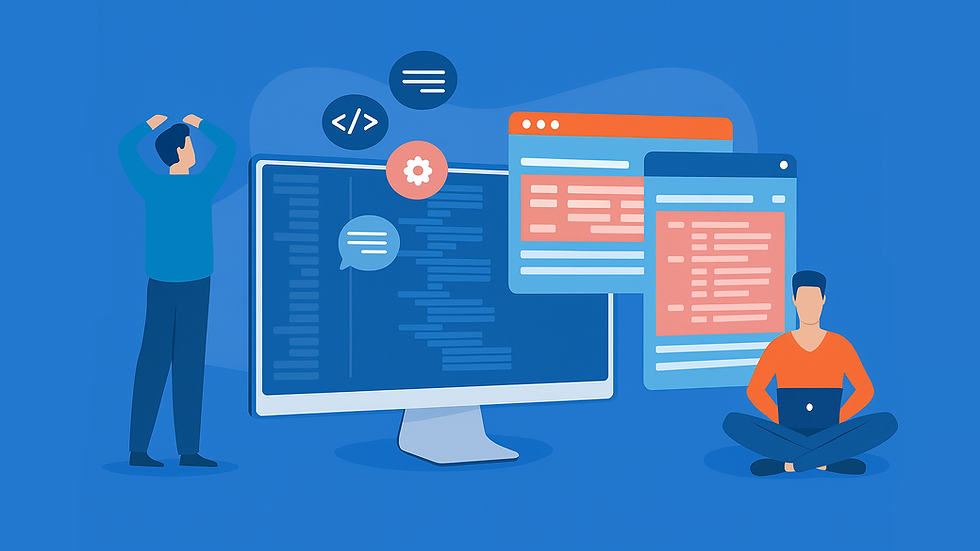- Ron Huber

- Jul 24
- 5 min read
Updated: Aug 18

The new player in the Developer Portal game is Artificial Intelligence. It reshapes how developers discover, explore, learn, and build with APIs. AI is dramatically changing the rules of DX, transforming static documentation into smart, personalized experiences, providing predictive recommendations, trouble-shooting in real-time, and more.
The era of Developer Portals with static repositories of API documentation is over. They have already evolved to interactive hubs for developers with dynamic, intelligent interfaces. These new API portal solutions enhance Developer Experience (DX), accelerate onboarding, and drive API adoption fast.
In today’s blog post, the team at Apiboost explores how AI is reshaping the Developer Portal experience and why a traditional setup may no longer be enough.
Why Traditional DevPortals Can’t Keep Up with AI
The AI ecosystem is advancing rapidly, with emerging agent protocols, real-time data flows, and continuously evolving API consumption patterns. Static portals and on-prem systems weren’t built for this pace. They lack the flexibility, governance, access control, and automation needed to adapt in real-time.
That’s where SaaS-based API developer portal comes in. With continuous updates, cloud-native infrastructure, and integration-ready architectures, they’re designed to evolve alongside your APIs and the broader AI landscape. Whether it’s embedding AI copilots, supporting multi-gateway environments, or auto-generating documentation and code snippets, a SaaS-based portal ensures your developer experience skyrockets.
→ Read more: What is a Developer Portal
The Impact of AI on Developer Portals
Artificial Intelligence already influences the Developer Portal experience. AI is revolutionizing how software is built, how developers interact with APIs, and, as a result, boost ROI. AI is driving Developer Portal changes in two main areas: the development time and user expectations.
Let’s break down these two categories below.
AI in Developer Portal Solutions is Increasing Development Speed
Development time is decreasing with AI-powered Developer Potals.
When your developer portal is integrated with AI-powered tools through a centralized platform like MCP, it becomes more than just a documentation center. It proactively accelerates development. By giving AI access to current information across your public and private APIs, developers can build and deploy with far greater speed and accuracy. This reduces delays across the development lifecycle and helps teams bring features and products to market faster.
Low-code solutions are significantly expanding.
Modern Developer Portals aren’t just serving professional software developers. They’re becoming launchpads for cross-functional teams, from product managers to marketers and vibe coders, who are using integrated tooling, templates, and intelligent guidance to build and test without writing traditional code.
An AI-powered Developer Portal that supports low-code use cases extends its reach beyond engineering. It becomes the control center for internal platforms, partner ecosystems, and sandboxed experimentation. The better the portal, the more it empowers cross-functional teams to move fast.
AI in Developer Portals Impact User Behavior and Expectations
AI is redefining how developers search within an API portal.
The shift from “search” to “ask” is real. AI-powered Developer Portals aren’t just indexing documentation but rather interpreting it. Developers can phrase complex questions in natural language and receive precise, context-aware responses. It’s not search-as-you-know-it. It’s answers-as-a-service.
This is a major leap from the traditional model, where users had to flip through pages of documentation, piece together information, and troubleshoot on their own. Now, AI cuts that time, reduces support tickets, and makes your portal more usable not just by developers, but also by product, QA, partners, and integration teams too.
Buyer personas are evolving.
Artificial Intelligence isn’t just changing how Developer Portals function. It’s changing what stakeholders, including developers, expect from them.
As AI-powered features like natural language search, predictive recommendations, and adaptive onboarding become more common, users, especially younger developers and hybrid product leads, start to expect that same level of intelligence in every platform. Developers expect context-aware, role-specific information tailored to their situation rather than having to read, interpret, and adapt legacy how-to guides for their needs. Today, buyer personas expect intuitive experiences on API portals.
Core Developer Portal AI Features
A lot of platforms throw around the “AI” label like it’s a feature in itself. But when it comes to Developer Portals, what AI features really work? Which AI capabilities bring real value instead of just sounding impressive? Let’s sort things out.
AI Integration via Developer Toolchains: Providing tool integrations via MCP or Agent-2-Agent protocol allows developers to leverage the Dev Portal AI from within their IDEs, CI/CD pipelines, or API testing tools. This extends the portal’s intelligence into the places where developers already work, increasing API adoption without changing habits.
GPT-Based Documentation Assistants: These assistants can generate, summarize, or explain documentation.
AI-Assisted Operational Tasks: SaaS-based API Portals don’t just surface documentation but also provide the AI with tools to perform curtain actions. By integrating with internal systems, the AI can help users obtain or manage API keys, request access to restricted APIs, and even monitor app performance using built-in analytics. This turns the portal into a hands-on assistant that supports the entire development lifecycle, not just discovery.
When the above-mentioned Developer Portal AI features are implemented right, developers spend less time guessing and more time shipping, which significantly accelerates the API adoption turnaround.
How an AI-Powered Developer Portal Drives ROI
It’s a common delusion to think Artificial Intelligence is about making life easier for developers only. Time to focus on what really matters to API owners: the numbers.
Smarter search means fewer support tickets. Personalized onboarding means faster integrations. Developers who enjoy DX within your portal are more likely to return, explore, and expand their use cases.
All of the above compounds. Better DX leads to better retention. Faster integration cycles translate into faster revenue recognition. Stronger engagement in your ecosystem opens the door to new partnerships and co-build opportunities.
By reducing support costs, accelerating time-to-first-call, and increasing integration depth through intelligent guidance and personalization, AI turns your Developer Portal into a revenue engine.
→ Read more: Why Investing in a Developer Portal Pays Off.
Pitfalls to Avoid When Implementing AI in Developer Portals
While AI offers significant advantages for API Portal solutions, it also brings new layers of responsibility. To ensure AI augments rather than undermines the Developer Experience, the following challenges must be addressed:
Data Security: When AI is layered into a Developer Portal, it must honor all existing access controls. It is crucial to control who has access to what information for each API. In DevPortals like Apiboost, where access can be segmented by API, role, and team, AI must be fully aware of and bound by those same rules.
Data Privacy: AI systems must comply with all applicable data protection regulations and ensure that any personal or behavioral data is collected, processed, and stored responsibly. Transparency around data usage is critical: users should know what’s being captured and why.
Model Accuracy: Regularly train and validate AI models to maintain accuracy and relevance.
User Trust: Be transparent about AI functionalities and provide options for users to opt-out or provide feedback.
Feature Overload: Avoid overwhelming users with too many AI features; focus on functionalities that offer clear value for end users.
Implementing AI thoughtfully ensures that it enhances rather than hinders the Developer Experience.
Summing Up
AI is now changing how developers interact with APIs and what they expect from the tools around them. But AI isn’t magic. The value comes from functionalities that solve real-world problems and boost Developer Experience, not trendy features. When developer portals pair intelligence with advanced governance, accessible support channels, and seamless workflows, they stop being static documentation hubs and start driving API adoption, engagement, and long-term growth.








